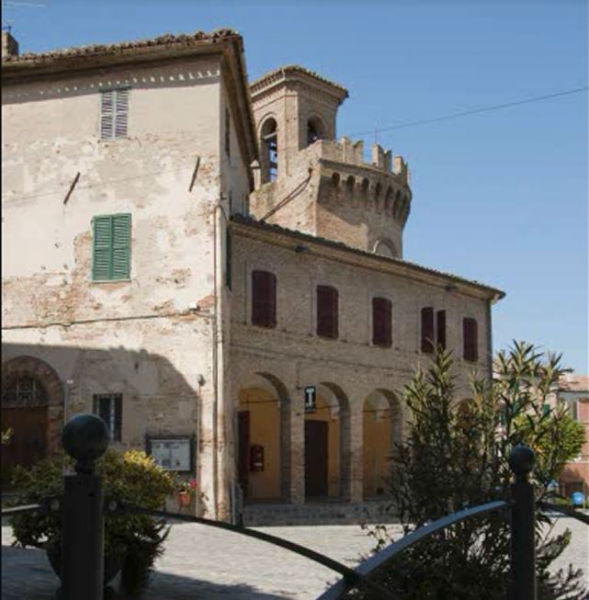
Erected towards the end of the eighteenth century and designed by Arch. Giannantonio Mengoni with Paolo Isidoro Capponi’s approval.
It holds an altar-piece depicting The Virgin with the Apostles (1620) by Cristoforo Roncalli, known as Pomarancio.
Here you can also admire a cup (1523) from the former church of Santa Maria d'Arco and a marble and wooden baptismal font dating 1708.
In the choir stalls above the front door, you will find the organ built by Feliciano Fedeli from Camerino in 1737 and restored in 1993.

Important natural area rich in flora and fauna where the stream Fossato flows before ending in Esino, the main river of the valley. Thanks to its position, Montecarotto has a drainage-basin particularly rich in surface waters both in autumn and in spring.
Have a relaxing walk along the park which still preserves the ruins of the old mill that drew power from the waters of the stream.
Explore the luxuriant nature of the area and discover the rare species of flowers like the fern and the dracontea.
Since its origin, Montecarotto has been the border line between Jesi and Senigallia and the junction of the Esino and Misa valleys.
Be entranced by the wonderful landscape! You will admire the entire province of Ancona, the river valleys until the peaks of the Apennines and “la Gola della Rossa”.
It’s easy to come here; by car going through the Arceviese SP and SS 76; Jesi is 18 km far , Ancona 47 km; Senigallia 30 km. Highway A14: exit Senigallia or Ancona Nord. By train: Montecarotto-Castelbellino railway station is 9 km far (line Ancona-Rome).
Many funny assumptions are linked to the name Montecarotto: according to popular belief the original name was Mons Iscariotae, that is the land where Judas Iscariot lived and hanged himself.
In reality, the name Montecarotto derives from the Latin Mons Arcis Ruptae the "Mountain of the destroyed fortress," a fortification situated atop the hill because of its strategic position and then abandoned before the thirteenth century. But nothing of the first phase is preserved, maybe the remains found under the church of La Collegiata di Santa Maria are the answer to this "mystery."
In 1248 the cardinal Rainerio, the Pope's vicar, recognized the rule of Jesi over Montecarotto and over the other castles. However, the power of Jesi became effective only in 1301, when Bishop Leonardo renounced his feudal rights. Montecarotto belonged definitely to the County of Jesi and was one of its prestigious castles.
In fact, during St. Florian festival, Montecarotto was the second castle to lay its bid after Massaccio (Cupra Montana).
The fifteenth century was particularly turbulent to Montecarotto which was ruled together with Jesi by Malatesta family from Rimini for a few years.
After ups and downs in 1431, Jesi took possession of the castle. In the second half of the 15th century, thanks to the acquisition of lands by the local owners, Montecarotto started an important development which lasted two centuries.
In the sixteenth century the castles under the rule of Jesi reacted and asked for greater administrative and financial autonomy. At the end of the century and then in 1636 serious plagues struck the area and caused a drastic decrease in population. However, in the sixteenth and seventeenth centuries Montecarotto showed a remarkable vitality by rebuilding the walls, commissioning works of art for churches, renewing the town charter and increasing cereal growing.
In the eighteenth century there was an increase in population and new struggles against Jesi started. But the attempts at independence had no success.
In fact, the dispute ended in 1752 with Pope Benedict XIV’s “motu proprio” pro Jesi. But in 1808 further to the establishment of the Napoleonic Kingdom of Italy, the castles of the County gained their independence.
Montecarotto boasts the vitality of the small entrepreneurship and the long-lived wine-producing tradition which allow it to preserve its identity.
Come here for a stimulating holiday amid the verdant pleasures of its vineyards and with the wide variety of its wines, you can’t afford not to taste!

Distance: km 35
Time advised: 3 hours
Difficulty: difficult
Starting from the parking in front of the cellar Colonnara and following the signs indicating the historic centre, take the road that leads to Staffolo until you reach the junction called Pian della Casa. Then turn to the right for Apiro. Once arrived in Apiro, head to Piani di Apiro; near the pool, follow the road down the hill that borders the pine forest . Continue until you cross the white road; turn right and shortly after, again on the right side of the church, take the white road downhill through the woods (dangerous descent, be careful!).
After a series of ups and downs through woodland, turn left for the tarmac road that leads to the source of Crevalcuore. Follow the tarmac road for about 2 km, turn left at the junction and go uphill on the white road until you reach Valcarecce. Having passed the hamlet, turn right; continue along the white road over a series of ups and downs and at the junction of the hamlet called Ca de Berti, take the road on the left which soon after reaches the Church of Colognola. At the next intersection with a large metal Crucifix, turn right and follow the main road downhill. From the stream Acqualta take the road to Staffolo and proceed downhill to San Paolo. Near the war memorial of San Paolo, take the tarmac road to the source of Barbanera and turn right onto the dirt road leading to the ditch of Follonica. Having crossed the first bridge, turn right for the second bridge where the steep path climbs up to San Michele.
Having passed the Church of San Michele, take the white road on the left following the sign indicating Contrada Colonnara. After about 600 metres, turn right at the junction and start climbing calmly because there is a difference in height of about 200 metres with a sixteen per cent gradient.
At the end of the climb marked by the “Stop”,follow the signs indicating “Conad” and you easily reach the point of departure.














